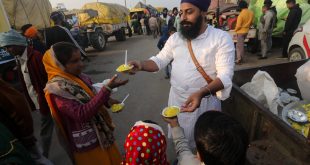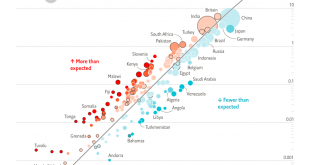[embedded content]A demand-led growth perspective of Indian development. Book available here. Comments by Alex Thomas.
Read More »Why are so many African and Asian nations ambivalent about Russia’s invasion? International identity politics
Americans agree on few issues, but one thing they have come together on is condemnation of Russian aggression. Western Europeans too. But not so the rest of the world. To explain India’s muted diplomatic reaction, Western papers emphasize the fact that India gets most of its arms from Russia, but here is an interesting NPR panel broadening the view: FRAYER: And the news commentary here about sanctions and diplomacy is also often sympathetic to Russia. Listen to how one of India’s most...
Read More »Remembrances of an Indian development economist
The statistical assistants at ISI were literally called ‘computers’ (I was a bit taken aback when on the first day a man came to see me and said “I am your computer, sir”). One day when I was chatting with this human ‘computer’, he said some years back he had worked with a foreign professor who was rather short-tempered and used to scream at him for the slightest delay or lapse. (It so happened that I knew this professor). I said he should have protested if the professor was unnecessarily...
Read More »An Accommodative Fiscal Stance Is Crucial for India
by Lekha Chakraborty and Harikrishnan S. Omicron is a reminder that the COVID-19 pandemic is still not over. This ongoing health crisis should act as a trigger for greater investments in public health in India. Public spending on health by the union government is still below 1 percent of GDP, though the estimate has increased from 0.2 percent of GDP in 2020–21 (revised estimates) to 0.4 percent of GDP in 2021–22 (budget estimates). Strengthening investments in the healthcare sector is...
Read More »An Accommodative Fiscal Stance Is Crucial for India
by Lekha Chakraborty and Harikrishnan S. Omicron is a reminder that the COVID-19 pandemic is still not over. This ongoing health crisis should act as a trigger for greater investments in public health in India. Public spending on health by the union government is still below 1 percent of GDP, though the estimate has increased from 0.2 percent of GDP in 2020–21 (revised estimates) to 0.4 percent of GDP in 2021–22 (budget estimates). Strengthening investments in the healthcare sector is...
Read More »Is Climate Change a Fiscal or Monetary Policy Challenge?
Lekha Chakraborty(Professor, NIPFP, and Member of Governing Board, International Institute of Public Finance, Munich) Climate change is about risks and uncertainty. How well the monetary policy stance can incorporate such risks and uncertainties is questioned by many economists. There is a broad consensus among economists that fiscal policy is capable of dealing with the climate crisis but monetary policy is not, due to the latter’s lack of tools. It is widely acknowledged that public...
Read More »Is Climate Change a Fiscal or Monetary Policy Challenge?
Lekha Chakraborty(Professor, NIPFP, and Member of Governing Board, International Institute of Public Finance, Munich) Climate change is about risks and uncertainty. How well the monetary policy stance can incorporate such risks and uncertainties is questioned by many economists. There is a broad consensus among economists that fiscal policy is capable of dealing with the climate crisis but monetary policy is not, due to the latter’s lack of tools. It is widely acknowledged that public...
Read More »IPA’s weekly links
Guest post by Jeff Mosenkis of Innovations for Poverty Action. A quick note, my posting frequency has slowed down in 2021, thanks for sticking with it. One reason has been that I’ve been co-authoring another set of links with my brilliant IPA colleagues, Luciana Debenedetti & Rachel Strohm, every other week focused on new research on COVID and social protection (this week’s is here). Among other, I think I also hit what I now realize was a quarantine burnout. If it’s helpful to anybody...
Read More »Millions of India’s farmers fight for their economic lives
As a bit of a comparison, the 2018 Distribution of Federal Payroll and Income Taxes shows 761,000 household taxpayers making up 4 tenths of 1% of all taxpayers having the highest income in the US. I am not sure if we can get it as finite as what India shows in wealth. With a population of ~1.3 billion, the wealth of 831 individuals amounts to 25% of the nation’s GDP. The 831 are calling the shots for farmers in India and the nation. “Millions of...
Read More »IPA’s weekly links
Guest post by Jeff Mosenkis of Innovations for Poverty Action First a plug – my colleagues at IPA have done amazing work this year quickly pivoting a big research organization to tackle the covid crisis head-on, studying hunger, refugee issues, education and 80+ other topics, and staying up late into the night, over and over again. Not all of our expenses are covered directly by research grants, so we rely on donations for the rest. If you donate here BEFORE TUESDAY you gift will be...
Read More » Heterodox
Heterodox



